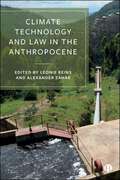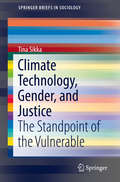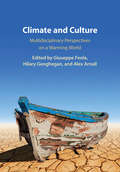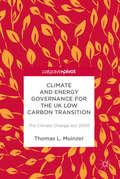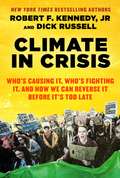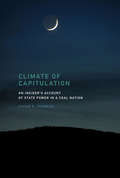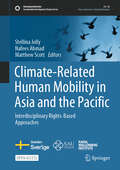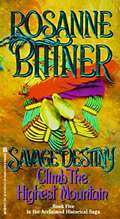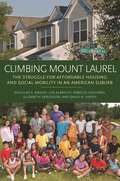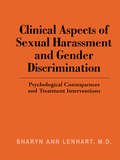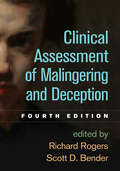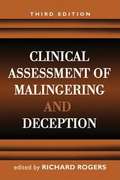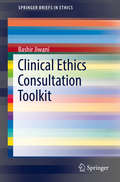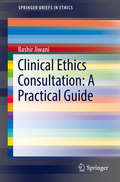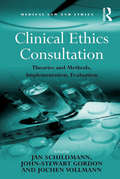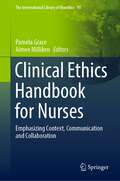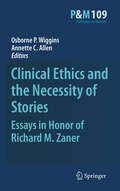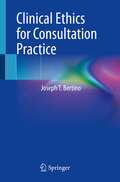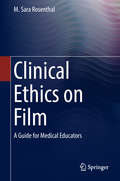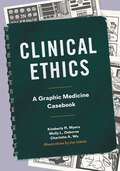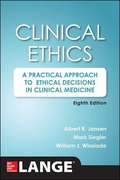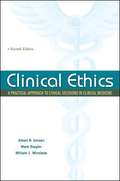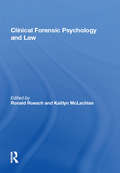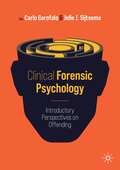- Table View
- List View
Climate Solutions: A Citizen's Guide
by Peter BarnesIn 2006, NASA's top climate scientist warned that we have at most a decade to turn the tide on global warming. After that, James Hansen said, all bets are off. Temperature rises of 3 to 7 degrees Fahrenheit will "produce a different planet." If Hansen is right--and most scientists think he is--then every year lost is a year closer to the precipice. In more positive terms, we have one last chance-but one chance only-to save the planet. This guide is about that last chance. It's a result of hundreds of how-do-we-do-this-right discussions over many years. Author and entrepreneur Peter Barnes want to share what he's learned in these discussions because the climate crisis must be solved now, and popular understanding is a prerequisite to getting a solution that actually solves the problem. As a result of these numerous discussions, Barnes come to appreciate that climate policy isn't as simple as one would want it to be. But it's not rocket science, either. When details get complicated, the key is to remember what we, as a nation and a species, must very quickly do: install a workable and lasting system for limiting our use of the atmosphere.
Climate Technology and Law in the Anthropocene
by Leonie Reins and Alexander ZaharAvailable open access digitally under CC-BY-NC-ND licence. As climate change accelerates, our window for action is closing. To stay within the "Anthropocene" - an epoch in which humankind as the dominant force shaping the planet retains a degree of control over the destructive processes it has unleashed - global warming must be kept below 2° Celsius. This book explores the unprecedented technological and legal changes required to achieve this. Featuring contributions from leading experts, the essays examine the intersection of technology, law, and environmental values, offering diverse viewpoints on navigating the Anthropocene. Revealing the controversies of rapid technological adoption and legal reform, this is a crucial analysis of a complex future whose many dangers for our society are barely understood.
Climate Technology, Gender, and Justice: The Standpoint Of The Vulnerable (Springerbriefs In Sociology Ser.)
by Tina SikkaThis book is the first to undertake a gendered analysis of geoengineering and alternative energy sources. Are either of these technologies sufficiently attendant to gender issues? Do they incorporate feminist values as articulated by the renowned social philosopher Helen Longino, such as empirical adequacy, novelty, heterogeneity, complexity and applicability to human needs? The overarching argument in this book contends that, while mitigation strategies like solar and wind energy go much further to meet feminist objectives and virtues, geoengineering is not consistent with the values of justice as articulated in Longino's feminist approach to science. This book provides a novel, feminist argument in support of pursuing alternative energy in the place of geoengineering. It provides an invaluable contribution for academics and students working in the areas of gender, science and climate change as well as policy makers interested in innovative ways of taking up climate change mitigation and gender.
Climate and Culture: Multidisciplinary Perspectives on a Warming World
by Giuseppe Feola Hilary Geoghegan Alex ArnallHow does culture interact with the way societies understand, live with, and act in relation to climate change? While the importance of the exchanges between culture, society and climate in the context of global environmental change is increasingly recognised, the empirical evidence is fragmented and too often constrained by disciplinary boundaries. Written by an international team of experts, this book provides cutting-edge and critical perspectives on how culture both facilitates and inhibits our ability to address and make sense of climate change and the challenges it poses to societies globally. Through a set of case studies spanning the social sciences and humanities, it explores the role of culture in relation to climate and its changes at different temporal and spatial levels; illustrates how approaching climate change through the cultural dimension enriches the range and depth of societal engagements; and establishes connections between theory and practice, which can stimulate action-oriented initiatives.
Climate and Energy Governance for the UK Low Carbon Transition: The Climate Change Act 2008
by Thomas L MuinzerThe UK Climate Change Act was the first case of a country implementing blanket legally binding long-term emissions reduction targets in order to combat climate change. This book provides the first accessible and in-depth analysis of the UK’s complex Climate Change Act framework, presenting the discussion in a clear and interdisciplinary manner designed to open the workings of the challenging framework to a broad audience. It discusses the political ‘story’ surrounding the framework, and its treatment in scholarly environmental literature; analyses the technical content of the Act; explores the framework’s international significance, and its internal ‘subnational’ dimensions and impact, engaging the UK’s devolved jurisdictions of Northern Ireland, Scotland, and Wales. This first, much-needed interdisciplinary treatment of the framework is both introductory and analytical in nature and will be of interest to scholars, practitioners and general readers of environmental studies, policy and governance.
Climate in Crisis: Who's Causing It, Who's Fighting It, and How We Can Reverse It Before It's Too Late
by Dick Russell Robert F. Kennedy Jr.The science is overwhelming; the facts are in. The planet is heating up at an alarming rate and the results are everywhere to be seen. Yet, as time runs out, climate progress is blocked by the men who are profiting from the burning of the planet: Energy moguls like the Koch brothers and ExxonMobil CEO Rex Tillerson. Powerful politicians like Senators Mitch McConnell and Jim Inhofe, who receive massive contributions from the oil and coal industries. Most of these men are too intelligent to truly believe that climate change is not a growing crisis. And yet they have put their profits and careers ahead of the health and welfare of the world&’s population—and even their own children and grandchildren. How do they explain themselves to their offspring, to the next generations that must deal with the environmental havoc that these men have wreaked? With a new introduction from the authors, Climate in Crisis takes a very personal look at this global crisis, literally bringing it home.
Climate of Capitulation: An Insider's Account of State Power in a Coal Nation
by Vivian E. ThomsonHow power is wielded in environmental policy making at the state level, and how to redress the ingrained favoritism toward coal and electric utilities. The United States has pledged to the world community a reduction in greenhouse gas emissions by 26–28 percent below 2005 levels in 2025. Because much of this reduction must come from electric utilities, especially coal-fired power plants, coal states will make or break the U.S. commitment to emissions reduction. In Climate of Capitulation, Vivian Thomson offers an insider's account of how power is wielded in environmental policy making at the state level. Thomson, a former member of Virginia's State Air Pollution Control Board, identifies a “climate of capitulation” in state government—a deeply rooted favoritism toward coal and electric utilities in states' air pollution policies.Thomson narrates three cases involving coal and air pollution from her time on the Air Board. She illuminates the overt and covert power struggles surrounding air pollution limits for a coal-fired power plant just across the Potomac from Washington, for a controversial new coal-fired electrical generation plant in coal country, and for coal dust pollution from truck traffic in a country hollow. Thomson links Virginia's climate of capitulation with campaign donations that make legislators politically indebted to coal and electric utility interests, a traditionalistic political culture tending to inertia, and a part-time legislature that depended on outside groups for information and bill drafting. Extending her analysis to fifteen other coal-dependent states, Thomson offers policy reforms aimed at mitigating the ingrained biases toward coal and electric utilities in states' air pollution policy making.
Climate-Related Human Mobility in Asia and the Pacific: Interdisciplinary Rights-Based Approaches (Sustainable Development Goals Series)
by Matthew Scott Stellina Jolly Nafees AhmadThis open access book critically examines the policies and practices related to climate-related human mobility in Asia-Pacific and the legal and policy protection framework for climatically displaced migrants (CDMs) through an interdisciplinary human rights-based approach. While covering the policy and theoretical dimensions of mobility, it also evaluates the issue through empirical studies. The book illustrates how interdisciplinary rights-based approaches address and identify gaps in the protection framework for the region regarding dimensions of climate change displacement, migration, forced migration, susceptibility to climate change, and typology of climate change-induced displacement. Presenting multiple case scenarios, it recommends a legal mechanism based on human rights in a region brimming with variety and multiculturalism. Bringing together voices from the Asia-Pacific Academic Network on Disaster Displacement, the book examines issues that are immediately relevant in countries where they are living and working. In addition to academic perspective, the chapters also bring perspectives from positions held in national human rights institutions and government. They bring insight into lived experience and policy processes, seeking to avert, minimize, and address displacement, including through general disaster risk reduction and climate change adaptation initiatives, as well as specific initiatives around emergency preparedness for response and planned relocation and resettlement. The chapters examine diverse forms of human mobility, including displacement, planned relocation, and forced immobility. The combination of studies focusing on both sudden onset and slower onset movement is also distinctive. With a thorough understanding of the interdisciplinary rights-based approaches to the issue, students, researchers, policymakers, administrators, and all those engaged in studying these topics can quickly evaluate and appreciate how the rights of CDMs are protected on a national, regional, and international level in Asia-Pacific.
Climb the Highest Mountain (Savage Destiny, #5)
by Rosanne BittnerAlthough many years had passed since Abbie and Lone Eagle began life together, challenges still threatened them. Now, homesteaders have come to the rugged western frontier, determined to wrest the land from the forbidden lovers and their "heathen" people. But two hearts as strong and defiant as theirs would overcome this danger, as, together, they struggled to hold on to their way of life and embrace their SAVAGE DESTINY.
Climbing Mount Laurel: The Struggle for Affordable Housing and Social Mobility in an American Suburb
by Douglas S. Massey David N. Kinsey Elizabeth Derickson Len Albright Rebecca CascianoA close look at the aftereffects of the Mount Laurel affordable housing decisionUnder the New Jersey State Constitution as interpreted by the State Supreme Court in 1975 and 1983, municipalities are required to use their zoning authority to create realistic opportunities for a fair share of affordable housing for low- and moderate-income households. Mount Laurel was the town at the center of the court decisions. As a result, Mount Laurel has become synonymous with the debate over affordable housing policy designed to create economically integrated communities. What was the impact of the Mount Laurel decision on those most affected by it? What does the case tell us about economic inequality?Climbing Mount Laurel undertakes a systematic evaluation of the Ethel Lawrence Homes—a housing development produced as a result of the Mount Laurel decision. Douglas Massey and his colleagues assess the consequences for the surrounding neighborhoods and their inhabitants, the township of Mount Laurel, and the residents of the Ethel Lawrence Homes. Their analysis reveals what social scientists call neighborhood effects—the notion that neighborhoods can shape the life trajectories of their inhabitants. Climbing Mount Laurel proves that the building of affordable housing projects is an efficacious, cost-effective approach to integration and improving the lives of the poor, with reasonable cost and no drawbacks for the community at large.
Clinical Aspects of Sexual Harassment and Gender Discrimination: Psychological Consequences and Treatment Interventions
by Sharyn Ann LenhartThis book addresses the psychological impact of sexual harassment and gender discrimination from both a clinical and theoretical perspective, whereas previous literature on the topic has emphasized legal and employment consequences. To start, Lenhart provides a comprehensive summary and integration of existing literature and discusses relevant aspects of the workplace and legal environments. The second portion of the book deals with the psychodynamics of sexual harassment and gender discrimination, placing these violations in proper psychological perspective, along the same lines as rape, battering and other forms of gender-based abuse. The wide spectrum of psychological consequences of discrimination will be discussed and an effective and integrative model for intervention and treatment will be presented.
Clinical Assessment of Malingering and Deception, Fourth Edition
by Richard Rogers Scott D. BenderWidely used by practitioners, researchers, and students--and now thoroughly revised with 70% new material--this is the most authoritative, comprehensive book on malingering and other response styles. Leading experts translate state-of-the-art research into clear, usable strategies for detecting intentional distortions in a wide range of psychological and psychiatric evaluation contexts, including forensic settings. The book examines dissimulation across multiple domains: mental disorders, cognitive impairments, and medical complaints. It describes and critically evaluates evidence-based applications of multiscale inventories, other psychological measures, and specialized methods. Applications are discussed for specific populations, such as sex offenders, children and adolescents, and law enforcement personnel. New to This Edition *Many new authors and topics. *Thoroughly updated with current data, research methods, and assessment strategies. *Chapters on neuropsychological models, culturally competent assessments, psychopathy, and conversion disorder. *Chapters on psychological testing in child custody cases and in personnel selection/hiring.
Clinical Assessment of Malingering and Deception, Third Edition
by Richard RogersWidely regarded as the standard reference in the field, this book provides essential tools for understanding and assessing malingering and other response styles in forensic and clinical contexts. An integrating theme is the systematic application of detection strategies as conceptually grounded, empirically validated methods that bridge different measures and populations. Special topics include considerations in working with children and youth. From leading practitioners and researchers, the volume reviews the state of the science and offers best-practice guidelines for maximizing the accuracy of psychological and psychiatric evaluations.
Clinical Ethics Consultation Toolkit (SpringerBriefs in Ethics)
by Bashir JiwaniThis workbook is a companion to Clinical Ethics Consultation: A Practical Guide to Changing Culture, Building Capacity and Solving Problems Case by Case. The Toolkit lays out the process for clinical ethics consultation in a series of steps within five phases: Pre-Consult, Interviews, Mid-Consult, Consult meeting(s), and Post-Consult. For each step, the Toolkit provides directions for how to complete it, tips for success, and worksheets for capturing data and analysis. The Clinical Ethics Consultation Toolkit is the playbook from which clinical ethics consultants can draw methods and strategies for effectively delivering ethics consultation.
Clinical Ethics Consultation: A Practical Guide (SpringerBriefs in Ethics)
by Bashir JiwaniThis book provides a careful and comprehensive, step-by-step method for providing clinical ethics consultation. This Guide can be applied in almost any healthcare setting and takes the reader from establishing an intake process and developing strategies for interviewing those involved in the situation, to undertaking a consultation meeting and following up on a clinical consult. The book is an invaluable resource to any clinical ethicist, or committee or consult team member who is seeking to provide their service with rigour and quality. Written in simple language, the book explores ideas and concepts that will help the reader to understand, think through, and ultimately offer useful ethical consultation when facing ethically challenging issues.
Clinical Ethics Consultation: Theories and Methods, Implementation, Evaluation (Medical Law And Ethics Ser.)
by John-Stewart GordonThis volume brings together researchers from different European countries and disciplines who are involved in Clinical Ethics Consultation (CEC). The work provides an analysis of the theories and methods underlying CEC as well a discussion of practical issues regarding the implementation and evaluation of CEC. The first section deals with different possible approaches in CEC. The authors explore the question of how we should decide complex cases in clinical ethics, that is, which ethical theory, approach or method is most suitable in order to make an informed ethical decision. It also discusses whether clinical ethicists should be ethicists by education or rather well-trained facilitators with some ethical knowledge. The second chapter of this book focuses on practical aspects of the implementation of CEC structures. The analysis of experienced clinical ethicists refers to macro and micro levels in both developed and transitional countries. Research on the evaluation of CEC is at the centre of the final chapter of this volume. In this context conceptual as well as empirical challenges with respect to a sound approach to judgements about the quality of the work of CECs are described and suggestion for further research in this area are made. In summary this volumes brings together theorists and healthcare practitioners with expertise in CEC. In this respect the volume serves as good example for a multi- and interdisciplinary approach to clinical ethics which combines philosophical reasoning and empirical research.
Clinical Ethics Handbook for Nurses: Emphasizing Context, Communication and Collaboration (The International Library of Bioethics #93)
by Pamela Grace Aimee MillikenThis handbook provides tools for nurse educators, ethics educators, practicing nurses and allied health professionals for developing confidence and skill in ethical decision making in interdisciplinary settings such as acute and chronic care hospitals and clinics. It is useful for all healthcare personnel who face ethical issues in the course of their work and who work with nurses to resolve these issues. While the content is based on a US context, the concerns of nurses internationally are discussed and emphasized. Nurses working in acute and chronic care settings face many obstacles to providing good care and are often the first line of defense related to patient safety and meeting the needs of patients and their families. Some of the obstacles to optimal patient care are institutional, some sociocultural, and others the result of inadequate communication. Evidence points to the idea that while nurses do have the knowledge and skills to address practice problems of various sorts, they may not be confident in their skills of ethical decision making and advocacy actions. This is a resource to develop moral agency on behalf of individuals and to address broader barriers to good care raised at the local, community, or social levels.
Clinical Ethics and the Necessity of Stories: Essays in Honor of Richard M. Zaner (Philosophy and Medicine #997)
by Annette C. Allen Osborne P. WigginsThis collection of articles honors the work of Richard Zaner, a distinguished philosopher who has worked for over twenty years as an ethics consultant at Vanderbilt University Medical Center. His work in the clinical setting, especially the use of narrative in understanding what is going on in this setting is the focus of some of the papers, others relate his methodology and phenomenological approach to the more standard bioethical problemata and approaches. The essential questions: what then is the role of the philosopher turned medical ethicists? Is medical ethics a form of applied philosophy, or is it also a form of therapy? distinguish Zaner's phenomenology from hermeneutical philosophy.
Clinical Ethics for Consultation Practice
by Joseph T. BertinoThis book provides a robust analysis of the history of clinical ethics, the philosophical theories that support its practice, and the practical institutional criteria needed to become a practicing clinical ethicist.Featuring cases and a step-by-step approach, this book combines knowledge points associated with moral philosophy and medicine with general skill objectives for ethics consultants. The book aids in developing analytic moral reasoning skills for clinical ethicists, fostering the comprehensive education and professional development of clinical ethics consultants. In addition, it offers key components of how an ethics consultation curriculum manifest in an educational venue for clinical ethicists are illustrated. Adaptable and relevant for educating multiple disciplines in health care, this resource enables ethicists to understand the philosophical foundations and practical application of clinical ethics.
Clinical Ethics on Film: A Guide for Medical Educators
by M. Sara RosenthalThis book discusses feature films that enrich our understanding of doctor-patient dilemmas. The book comprises general clinical ethics themes and principles and is written in accessible language. Each theme is discussed and illuminated in chapters devoted to a particular film. Chapters start with a discussion of the film itself, which shares details behind the making of the film; critical reception; casting and other facts about production. The chapter situates the film in a history of medicine and medical sociology context, analyzes ethical issues raised in the film from a clinical ethics lens, and explains to readers how to use each film as a teaching aid for clinical ethics. Readers will understand how each film in this collection served to bring particular clinical ethics issues to the public’s attention, or reflected medico-legal issues that were part of the public discourse. The book is a perfect instructor's guide for anyone teaching bioethics, healthcare ethics, medical sociology, medical history, healthcare systems narrative medicine, or nursing ethics.
Clinical Ethics: A Graphic Medicine Casebook (Graphic Medicine)
by Kimberly R. Myers Molly L. Osborne Charlotte A. WuMr. Ito’s children act as his informal translators, but his doctor isn’t sure their translations are accurate or complete. Is Mr. Ito getting the medical information he needs?Ten-year-old Hannah arrives for her checkup with a bruised nose and an irritable father. Medical student Melanie is concerned for Hannah’s safety but wary of making accusations without evidence.Dr. Joshi worries that her patient is putting her husband, who is also Dr. Joshi’s patient, at risk by concealing a sexually transmitted disease. How can she act in the interest of both husband and wife without compromising doctor-patient confidentiality?Using the accessible and richly layered medium of comics, this collection reveals how ethical dilemmas in medical practice play out in real life. Designed for the classroom, Clinical Ethics provides an excellent introduction to medical ethics and presents case studies that will spark meaningful discussions among students and practitioners. The topics covered include patient autonomy, informed consent, unconscious bias, mandated reporting, confidentiality, medical mistakes, surrogate decision-making, and futility. The “Questions for Further Reflection” and “Related Readings” sections provide additional materials for a deeper exploration of the issues.Co-created by experts in clinical medicine, ethics, literature, and comics, Clinical Ethics presents a new way for students and practitioners to engage with fundamental concerns in medical ethics.
Clinical Ethics: A Practical Approach to Ethical Decisions in Clinical Medicine
by Albert R. Jonsen William J. Winslade Mark SieglerTrust the proven "Four Box" method to formulate ethically appropriate recommendations for patient care. Clinical Ethics teaches healthcare providers how to effectively identify, evaluate, and resolve ethical issues in clinical medicine. Using the author acclaimed "Four Box Method" and numerous illustrative case examples, this book enables practitioners to gain a better understanding of the complexities involved in ethical cases and demonstrates how to reach resolution to ethical problems. Clinical Ethics goes beyond theory to offer a decision-making strategy applicable to real-world practice. Readers will learn an easy-to-apply system based on simple questions about medical indications, patient preferences, quality of life, and contextual features that clearly explain clinical ethics and help them formulate a sound diagnosis and treatment strategy. The case examples have been selected to demonstrate how principles apply to real-world everyday practice. The co-authors, a bioethicist, a physician and a lawyer/ psychoanalyst /philosopher, draw on more than forty years respectively of clinical experience to select exemplary cases of ethical problems and to reflect on how moral principles and concepts can guide clinicians in formulating ethically appropriate recommendations for patient care. A unique chapter organization: Each chapter of the book begins with some general considerations about the topic, and the ethical principle relevant to that topic. The clinical situations that generate ethical problems are then described and illustrated by clinically realistic medical cases. A short distillation of current opinion from the bioethical literature is provided, followed by an analysis of the cases. . The authors conclude with recommendations that the three authors have formulated from their extensive experience as bioethics consultants.
Clinical Ethics: A Practical Approach to Ethical Decisions in Clinical Medicine (Seventh Edition)
by Albert R. Jonsen William J. Winslade Mark SieglerThis book is about the ethical issues that clinicians encounter in caring for patients such as informed consent, truth telling, confidentiality, privacy, the distinction between research and clinical care, and end-of-life care.
Clinical Forensic Psychology and Law (International Library Of Psychology)
by Kaitlyn McLachlanClinical Forensic Psychology and Law is a compilation of recent and classic articles providing comprehensive coverage of the field of clinical forensic psychology and law. Selected articles sample the major areas of the discipline, including criminal and civil forensic assessment, forensic treatment, youth assessment and intervention, and professional and ethical issues in forensic practice. The volume is designed for use by scholars, graduates and undergraduates in psychology and law schools.
Clinical Forensic Psychology: Introductory Perspectives on Offending
by Carlo Garofalo Jelle J. SijtsemaThis book represents a comprehensive collection of theoretical and empirical work at the nexus of clinical and forensic psychology written by world-renowned experts in the field. It is among the first books in the field to focus entirely on clinical psychological science applied to the understanding and treatment of offending. Part I addresses the main theoretical and clinical models used to explain and predict antisocial behavior, spanning biological, cognitive, experimental, individual differences, and interpersonal perspectives. Part II focuses on forms of psychopathology associated with an increased tendency to offend, with the emphasis on describing the clinical constructs most relevant for forensic psychology. Each chapter describes the clinical characteristics of one form of psychopathology, their assessment, their links with antisocial behavior, and treatment considerations. Part III focuses on different types of offense or offender groups as starting points. This perspective has relevance since many criminal justice and forensic mental health systems allocate offenders to interventions based on their index offense (or history of offenses). Finally, Part IV addresses the application of clinical psychology in the service of assessment and treatment in forensic settings. It includes the state of the art on diagnostic and risk assessment, as well as both widely used and recently developed interventions. This book is an excellent resource for students at both Bachelor’s and Master’s level, while also representing a comprehensive handbook for experienced researchers and practitioners.

